
Table of contents
- Choice of vessels
- Create a small water garden
- Preparation of planting
- The planting
- Suitable plants
- underwater plants
- floating plants
- water lilies
- shallow water plants
- Pond pump or other technical aids?
- Conclusion
So little space is not a problem. A water garden needs little space. There are many different options as to how it can be created. There are a few things to keep in mind though, especially for planted tanks. Fish or other animals have no place in these small vessels or basins, they cannot survive in them. When the sun is out, the water gets too warm, there isn't enough oxygen, and they would perish miserably.
Choice of vessels
There are ready-made versions of suitable vessels available commercially, often even with a small waterfall or fountain. Some can be planted, some better not. When choosing vessels, one should consider their durability and that they are not too heavy. In winter, the vessels are put away and who wants to lug them around? Caststone or polystone surfaces look like natural materials, although sand or stone are included. However, the weight is significantly reduced. A wooden tub is also suitable, but must be lined with pond liner. She is stapled to the edge. Overhanging film can be cut off. Glazed clay pots are also very attractive. The water glitters particularly effectively in them.
- Large selection of vessels made of different materials
- fiberglass
- caststone
- polystone
- wooden vats
- Zinc - very unfavorable - pollutants are released into the water
- Glazed clay pots
- Plastic, old baby baths, large collection containers
- Minimum volume - 40 liters, the larger the amount of water, the easier it is to maintain ecological balance, 50 cm water depth is favorable, but at least 30 cm
- mortar bucket
- earthenware
- natural stone troughs
- Alternative for the garden - air stone over a water reservoir embedded in the ground (childproof if the water basin is filled with stones or a grid is placed over it)
- Very interesting - high ponds
- Also for the garden - formal pools
Create a small water garden
For the sake of simplicity, take one of the vessels mentioned above. It should be waterproof. The best time to create such a water garden is between April and May. Frost should no longer be expected if you want to set up the mini pond outside. It's a little earlier on a sheltered terrace. The following things are required:
- mesh baskets
- pond fleece
- Pond soil or sand and clay in a ratio of 3:1
- pebbles (concrete gravel)
- planting shovel
- secateurs
- Rainwater from the bin or a water collection container
- brick(s)
- Plant
Preparation of planting
The plants bought for the water garden must be kept well moist until they are planted. In addition, the vessels must be cleaned thoroughly. Bacteria and germs can easily settle on the walls and these must be removed. Not all aquatic plants that are firmly planted like the same water depth. The level can be leveled out with bricks, gravel or other stones.
- Keep purchased plants moist
- Thoroughly clean vessels and rinse clean at the end to remove any cleaning agent residue.
- Place the vessel in its designated place. A semi-shady location, without direct midday sun, is best. The minimum is about 6 hours of sunshine per day.
- Balance the ground level, i.e. either work out a depth profile with gravel or place bricks of different heights on the subsoil.
The planting
Different plants are suitable for planting. The container should have a water depth of at least 30 cm for plants, 50 is better, then water lilies can also be used. It is best to use special plant baskets, small mesh baskets. When using pond soil, it is important that it remains in the container and is not washed out. Normal garden or potting soil must not be used.
- Line the mesh baskets with fleece. Calculate generously so it can still be folded up at the top.
- Place the root ball or rhizome in the lined basket and fill with pond soil. Water lily substrate can be used for water lilies.
- Press the surface firmly, fold the fleece edges inwards and place gravel on top
- Test with water so that no soil is washed out either. It shouldn't get into the water
- Use all plants like this
- At the end fill the bowl with water. Rainwater is best.
Tip:
If gravel is used for the water garden, it should always be washed beforehand. Unwashed gravel and other unwashed stones make the water cloudy.
Suitable plants
When choosing the plants, you should always make sure that they don't get too big, i.e. too tall, and don't spread too quickly. The entire water surface is quickly overgrown and that is not the point.
underwater plants
water buttercup – Water depth 30 to 80 cm, flowering June to September, white flowers, can form one meter long shoots, only for larger ones Surfaces of water, stalks float on the water, likes moving water, gets along well with calcareous water, has to from time to time be cleared
floating plants
shell flower – grows 5 to 10 cm high, flowers very rarely, 30 to 50 cm water depth, lettuce leaf rosettes, roots hang in the water, put into the water only at the end of May, like a lot of sun, warm water, stolons can be separated become
floating fern – grows to a height of 10 to 15 cm, does not flower, for 20 to 50 cm deep water, regular oval leaves on short, sparsely branched shoots, suitable for planting April, May, like nutrient-rich water, vigorous growth, always fish some leaves out of the water so that the water surface does not grows
water lilies
dwarf water lily(Nymphaea candida) – flower diameter 8 to 10 cm, flowering from June to August, water depth 25 to 50 cm (up to 80 cm), dark green round leaves (diameter 20 cm), white flowers, can be planted from May, press fertilizer kneaded into clay balls into the soil of the baskets in spring, hardy, quite growing
water lily(Nymphaea x pygmaea 'Helvola') – small yellow flowers, only 2.5 cm in diameter, flowers from June to September, water depth 20 to 25 cm, not hardy, dark green leaves, may have red to reddish-brown stripes or spots, fertilize in spring (as just described) ideal for containers, great with blue-flowering perennials at the edge
water lily (Nymphaea x laydekeri (Variety) – Flowers are pink (light purple-pink, darker inside or strong dark red with white markings, depending on the variety), up to 10 cm in diameter, flower June to September, water depth 25 to 30 cm, plants from mid-May, slow-growing, fertilize as described above, very willing to flower, ideal for bucket
Square water lily(Nymphaea tetragona) – small flowers, only 2.5 cm in diameter, pure white and fragrant, flowers from June to September, water depth 10 to 25 cm, can be planted from mid-May, most dainty water lily, even grows in flat bowls, then do not overwinter outdoors (commercially often under the name: Nymphaea x pygmaea 'Alba')
shallow water plants
swamp calla – 15 to 20 cm high and just as wide, white flowers between June and July, up to 20 cm deep, leaves sprout directly from the creeping rhizome, berries in Autumn (poisonous), plant from the end of April, without a planter, simply place the rhizome on the substrate and weigh it down with a flat stone, often dies in winter away
water spring – grows like a lawn, 20 to 40 cm high, evergreen, white to pale pink flowers from June to July, water depth up to 40 cm, shoots and leaves under water, flowers on bare stems above water, plant from the end of April, tolerates some shade, soft water is essential, substrate should be as acidic as possible, can be cut back in spring become
fir fronds – upright shoots with needle-shaped leaves in shallow water, 20 to 40 cm high and wide, inconspicuous flowers from June to August, water depth 10 to 30 cm, plant from the end of April, proliferating runners, therefore definitely put in a plant basket, cut off runners regularly, ideal for technology or bricks hide
water iris – Green-yellow striped leaves, up to 80 cm high, yellow flowers from May to July, planting depth 5 to 15 cm, needs sun and nutrient-rich water, beautiful spots of colour
Pond pump or other technical aids?
A pond pump is not absolutely necessary, but it helps to avoid an algae plague. From a purely visual point of view, a small fountain is also very nice. Both contribute to the aeration of the pond. However, if you want a water lily in the container, you must not install a fountain. Both don't go together. Water lilies do not like constant spraying. They also don't like too much water movement. In water gardens without vegetation, only chemicals can usually help to prevent algae. There are numerous agents that are simply added to the water and keep it clear. It is important to ensure that the additives are absolutely harmless, for humans anyway, but also for pets and birds, insects and other garden dwellers.
Conclusion
There is room for a small water garden anywhere. While you prefer to fill containers on the balcony and terrace, formal ponds can be used in the garden. They look good individually, but also in groups, for example used in a row. The important thing is the location the site. Sun is needed, but blazing midday sun is not ideal. If you want to use plants, you have to choose the right varieties. They must not grow too large and must not spread. Algae is also often a problem. Plants fight them, but in plantless containers it becomes difficult. Chemicals often have to be used here. If you like splashing, you can use a pump and/or fountain. Even in the smallest water basin there are many design options.
 garden editorial
garden editorial I write about everything that interests me in my garden.
Learn more about creating a pond
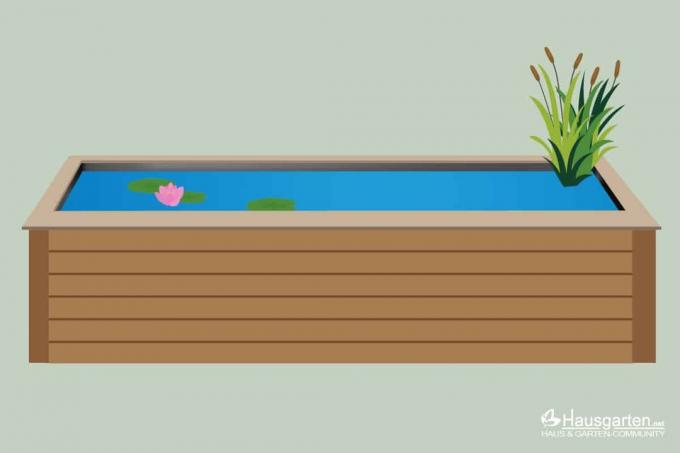
Build a high pond yourself: 15 tips for creating it yourself
A laborious excavation can be avoided with a raised pond. If you want to build and create it yourself, you should pay attention to numerous details. With the right tips, the project runs smoothly and long-term joy is guaranteed.

Build a duck coop yourself 7 tips for a duck house
Building a duck coop yourself is essential if you want to keep ducks yourself. But a protective shelter is also a practical and valuable aid for wild ducks. With our tips for building a duck house yourself, it's easy.
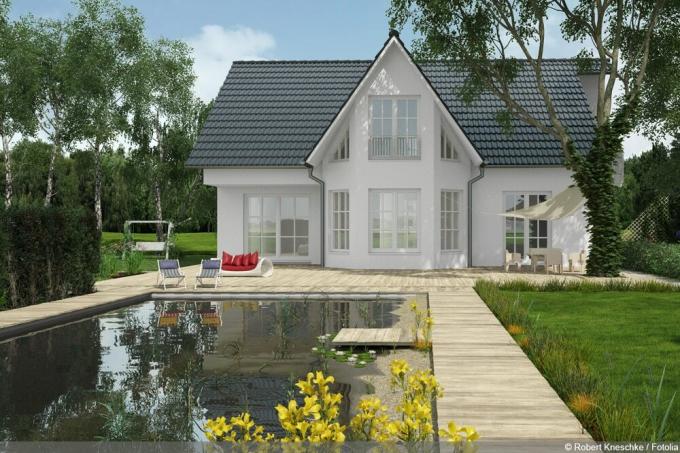
Make a swimming pond out of a garden pond: rebuild in 8 steps
Gardeners with manual skills transform the pond into a natural swimming paradise for the whole family. Thanks to the living sewage treatment plant, the private water world works in an exemplary manner without chemicals. This guide explains how to convert your garden pond into a swimming pond in 8 steps.
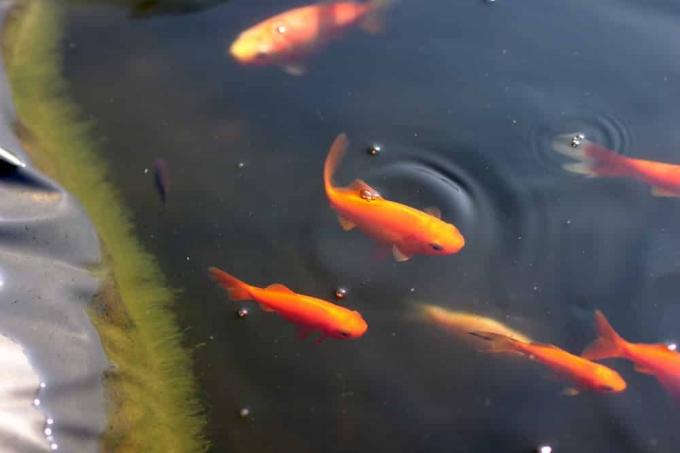
Fasten the edge of the pond: this is how the pond liner gets hold on the pond bank
Filled with water, maybe a few fish in it and attractively planted, a pond is a small piece of paradise in your garden. In order for this to remain so for a long time, the correct attachment of the edge and the pond liner is crucial.
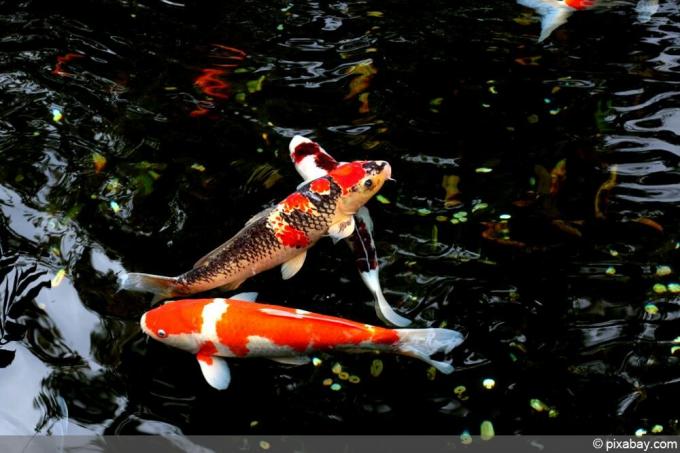
Creating a koi pond: requirements for size and filter system + costs
Kois are not only particularly noble, but also very demanding fish. Because the animals have certain requirements for their habitat, which must be taken into account when creating the koi pond.
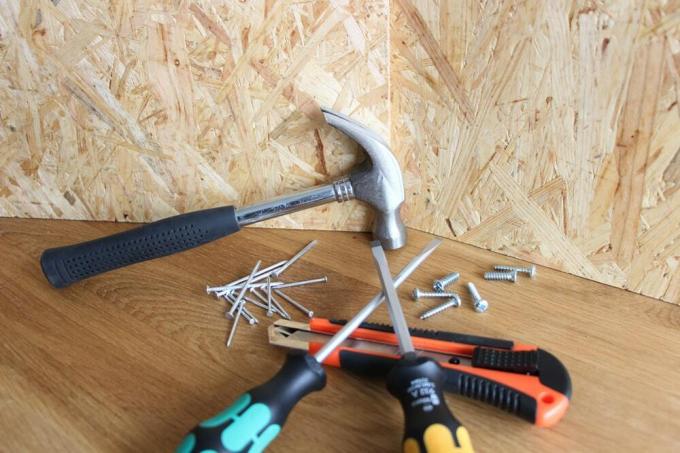
Build your own indoor pond – instructions in 10 steps
There are big differences in indoor ponds. A lot is possible, starting with plastic shells, such as those used in the garden, through brick and tiled ponds similar to a bathtub, to liner ponds in a wooden frame. Anyone who has never dealt with indoor ponds will be amazed at what some people come up with. Of course, the vessels can also be used for rooms, which are referred to as mini ponds or balcony ponds.



